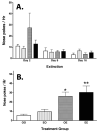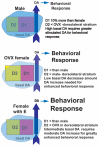Sex differences in drug abuse
- PMID: 17904621
- PMCID: PMC2235192
- DOI: 10.1016/j.yfrne.2007.07.003
Sex differences in drug abuse
Abstract
Sex differences are present for all of the phases of drug abuse (initiation, escalation of use, addiction, and relapse following abstinence). While there are some differences among specific classes of abused drugs, the general pattern of sex differences is the same for all drugs of abuse. Females begin regularly self-administering licit and illicit drugs of abuse at lower doses than do males, use escalates more rapidly to addiction, and females are at greater risk for relapse following abstinence. In this review, sex differences in drug abuse are discussed for humans and in animal models. The possible neuroendocrine mechanisms mediating these sex differences are discussed.
Figures



References
-
- Alele PE, Devaud LL. Sex differences in steroid modulation of ethanol withdrawal in male and female rats. Journal of Pharmacology & Experimental Therapeutics. 2007;320:427–36. - PubMed
-
- Andersen SL, Rutstein M, Benzo JM, Hostetter JC, Teicher MH. Sex differences in dopamine receptor overproduction and elimination. Neuroreport. 1997;8:1495–8. - PubMed
-
- Anglin MD, Hser YI, McGlothlin WH. Sex differences in addict careers. 2. Becoming addicted. American Journal of Drug & Alcohol Abuse. 1987;13:59–71. - PubMed
-
- Aragona BJ, Liu Y, Yu YJ, Curtis JT, Detwiler JM, Insel TR, Wang Z. Nucleus accumbens dopamine differentially mediates the formation and maintenance of monogamous pair bonds.[see comment] Nature Neuroscience. 2006;9:133–9. - PubMed
-
- Arnold AP, Gorski RA. Gonadal steroid induction of structural sex differences in the central nervous system. Annu Rev Neurosci. 1984;7:413–42. - PubMed

